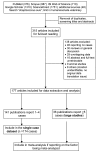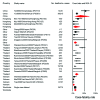Epidemiology, clinical manifestations, and outcomes of Streptococcus suis infection in humans
- PMID: 24959701
- PMCID: PMC4073838
- DOI: 10.3201/eid2007.131594
Epidemiology, clinical manifestations, and outcomes of Streptococcus suis infection in humans
Abstract
Streptococcus suis, a bacterium that affects pigs, is a neglected pathogen that causes systemic disease in humans. We conducted a systematic review and meta-analysis to summarize global estimates of the epidemiology, clinical characteristics, and outcomes of this zoonosis. We searched main literature databases for all studies through December 2012 using the search term "streptococcus suis." The prevalence of S. suis infection is highest in Asia; the primary risk factors are occupational exposure and eating of contaminated food. The pooled proportions of case-patients with pig-related occupations and history of eating high-risk food were 38.1% and 37.3%, respectively. The main clinical syndrome was meningitis (pooled rate 68.0%), followed by sepsis, arthritis, endocarditis, and endophthalmitis. The pooled case-fatality rate was 12.8%. Sequelae included hearing loss (39.1%) and vestibular dysfunction (22.7%). Our analysis identified gaps in the literature, particularly in assessing risk factors and sequelae of this infection.
Keywords: Streptococcus suis; bacteria; bacterial meningitis; humans; meta-analysis; systematic review; zoonoses.
Figures





References
-
- Hu X, Zhu F, Wng H, Chen S, Wang G, Sun J, et al. Studies on human streptococcal infectious syndrome caused by infected pigs [in Chinese]. Zhonghua Yu Fang Yi XueZaZhi. 2000;34:150–2. - PubMed
-
- Mai NT, Hoa NT, Nga TV. Linh le D, Chau TT, Sinh DX, et al. Streptococcus suis meningitis in adults in Vietnam. Clin Infect Dis. 2008;46:659–67. - PubMed
Publication types
MeSH terms
Grants and funding
LinkOut - more resources
Full Text Sources
Other Literature Sources
Medical

